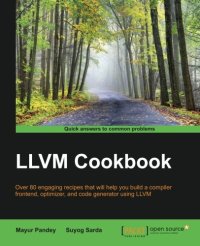
Ebook: LLVM Cookbook
Author: Mayur Pandey Suyog Sarda
- Tags: Assembly Language Programming Languages Tools Computers Technology Compiler Design Compilers C Reference Almanacs Yearbooks Atlases Maps Careers Catalogs Directories Consumer Guides Dictionaries Thesauruses Encyclopedias Subject English as a Second Etiquette Foreign Study Genealogy Quotations Survival Emergency Preparedness Test Preparation Words Grammar Writing Research Publishing
- Year: 2015
- Publisher: Packt Publishing
- Language: English
- epub
Over 80 engaging recipes that will help you build a compiler frontend, optimizer, and code generator using LLVM
About This Book
- Write a frontend for any language to generate LLVM IR
- Create optimization passes to optimize the IR code using LLVM Pass Infrastructure and Pass Manager
- Design and implement structures for highly-optimized compilers using LLVM, through detailed step-by-step recipes
Who This Book Is For
The book is for compiler programmers who are familiar with concepts of compilers and want to indulge in understanding, exploring, and using LLVM infrastructure in a meaningful way in their work.
This book is also for programmers who are not directly involved in compiler projects but are often involved in development phases where they write thousands of lines of code. With knowledge of how compilers work, they will be able to code in an optimal way and improve performance with clean code.
In Detail
LLVM is a compiler framework with libraries that provides a modern source-and target-independent optimizer, along with a code generator.
This book not only explains the effective use of the compiler infrastructure that LLVM provides, but also helps you implement it in one of your projects. You start with a simple task to get you up-and-running with LLVM, followed by learning the process of writing a frontend for a language, which includes writing a lexer, a parser, and generating IR code. You will then see how to implement optimizations at different levels, generate target-independent code, and then map this generated code to a backend. Finally, you will look into the functionalities that the LLVM infrastructure provides, such as exception handling, LLVM Utility Passes, using sanitizers, the garbage collector, and how we can use these in our projects.